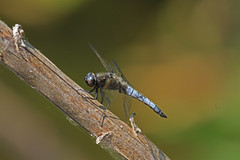My meanderings around Suffolk in February inevitably led me to RSPB Minsmere. I’d heard there were bittern (Botaurus stellaris, Dansk: rørdrum), which I’ve never seen before, and smew (Mergellus albellus, Dansk: lille skallesluger) which I’ve also never seen, in residence there. Indeed, theere had been an influx of bittern from Holland due to the fierce winter weather there and numbers were up, so I felt a little twitching was in order.
For those of you unfamiliar with the geography, Minsmere is characterised by woodland on the inland side to the north and east with a network of reedbeds and lakes behind a sand and shingle bank running along the coast. It lies between Dunwich Heath and the Coastguard Cottages to the north, and Sizewell to the south. It is a haven for numerous species of bird and my friend told me that on a morning trip there with a dawn start he spotted over 100 species of birds by lunchtime. And I reckon that’s an impressive tally. Many mammals also live and visit here including red deer, fox and otter.
As it is an RSPB reserve there are hides for observing the wildlife and as I set off along the bank which forms the sea defences to find one various gulls and great crested grebes (Podiceps cristatus, Dansk: toppet lappedykker) were on the sea. I paused to watch a marsh harrier (Circus aeruginosus, Dansk: rørhøg) quartering the reedbeds, and then headed on to an open hide where I installed myself to see what was in residence.

The view from the south end of the hide
From the lower right hand window of the hide are the reedbeds of the reserve and from the upper left window is the reactor dome of Sizewell nuclear power station. The power station reminds me that I’m very grateful for havens such as Minsmere but I also wonder why on earth does it have to be just there, the juxtaposition offends me somewhat. But there it is, so I contented myself with looking out the front of the hide and here are some of the birds I could see:

A lone lapwing foraging for sustenance
Immediately in front of my hide, in which I was the only occupant, was a water filled channel separated from the lakes just beyond by a thin strip of reeds, and immediately to the fore was a single lapwing (Vanellus vanellus, Dansk vibe). Low grassy islands in the lakes were home to various species of duck, the most numerous being…

Teal, two males and a female (Anas crecca, Dansk: krikand)

Shelduck (Tadorna tadorna, Dansk: gravand), and lurking in the background is a shoveler (Anas clypeata, Dansk: skeand)
All of these ducks are resident or nigrant breeders and winter visitors and where I am I only see them in winter. According to the BTO the teal is unusual in that it has no other names in the UK, which is an interesting little factlet which obviously needs to be challenged. If anyone knows of a local name for the teal please let me know. Another amusing piece of nomenclature is the shoveler, so named presumably for its shovel like beak and in Danish is known as the ‘skeand‘, which translates into English as the ‘spoon duck’. It uses it’s magnificent beak to filter small molluscs and crustaceans from the beds of shallow water by sweeping it across the surface and sifting the food from the disturbed sediment.
Alas, most of the birds were just too far away for my 300mm lens, but I plan to upgrade my optics this year so next time I post from Minsmere I’ll hopefully have lots of high quality close ups too.




I haven’t seen a bittern, no, I was hoping to see one in your post. 🙂
Good point that Theresa made, that is one benefit of having the reactor there.
I’ll post one as soon as I can take one 🙂 I’m on the case.
Interesting post as always Finn. The juxtaposition of Sizewell and the reserve is, to use the vernacular ‘one of those’ isn’t it? In a perfect world wildlife would be in a proper, aesthetically pleasing wild environment, but at least areas such as these are pretty safe; who else would want to be there? I don’t know any local names for Teal either – all I know is that the specific name ‘crecca’ is onomatopoeic, referring to the male’s characteristic call, so the scientific name of the Eurasian Teal – is as Linnaeus gave it – “duck that makes cryc”!
Hello Theresa, the onomatopoeic Latin name of the teal is interesting. You’ve probably noticed I include the Danish names of the birds too for my friends in Denmark, and the Danish name for the teal is ‘krikand‘ which literally translates as ‘krik-duck’. So the names cross borders.
No bittern? Lovely birds all the same. When I started reading your post the name Sizewell triggered a memory in my mind but it wasn’t until I saw the photo that I realised why. I had no idea it was so close to a nature reserve, it is an odd juxtaposition. In a way I suppose it’s nice to know that despite things like nuclear reactors, we still care enough about our wildlife to give substantial areas of land over to reserves like this one. Long may that tradition continue!
Have you seen a bittern? I’m yet to see one… but I shall keep looking.
Minsmere and the surroundings are an important place for wildlife but as Theresa said in her comment at least with the power station there it may deter other development in the area.